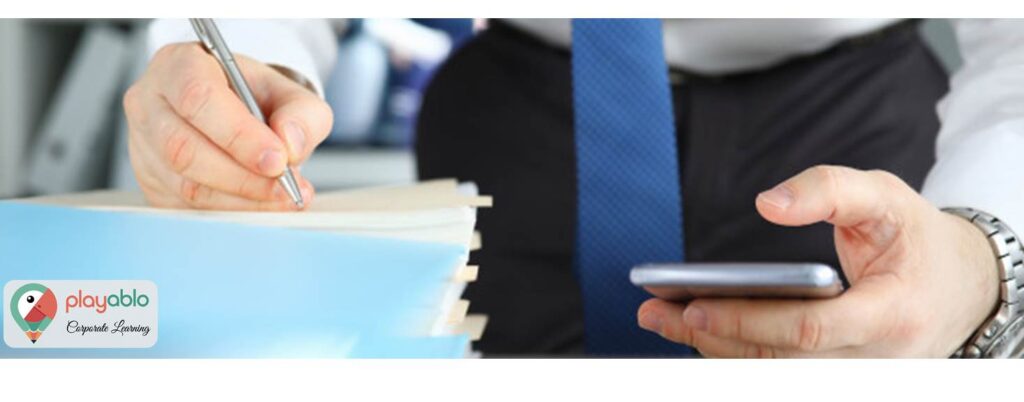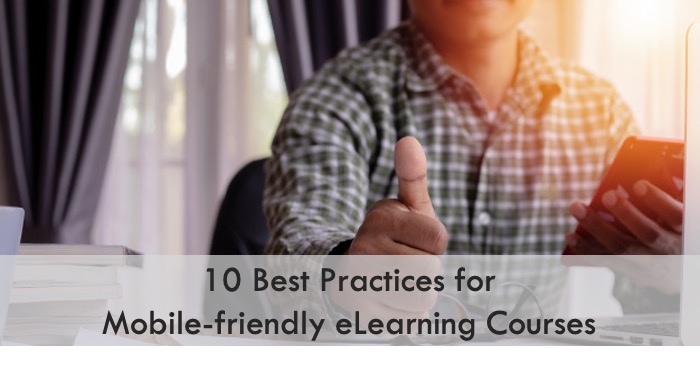Time and again, mobile learning has proved that it can stand up to its hype. And with the Millennial generation surging up in workplaces, m-learning has become indispensable. In fact, according to recent research, “71% of Millennials say they connect more with mobile learning than L&D activities delivered via desktop or formal methods.”
Yes, the modern employee is so used to the smartphone and accessing information at his/her fingertips. Be it entertainment, banking, social networking, shopping, or training, mobile phones rule the globe. Since mobile learning is such a necessity, you must have given some thought to implementing it in your organization.
Table of Contents
How to Create Effective Mobile Learning Content
However, simply making your materials accessible on mobile gadgets won’t do the job. It would be best if you considered multiple other factors. Hence, to help you out, here are our 12 hand-picked best practices to create learning courses for mobiles.
1. Remove Unnecessary Information

The wiring of the human mind does not allow the absorption of too much information in one go. Therefore, if mobile learning bombards your learners with lengthy, unwanted content, they might get overwhelmed and leave. Our brains have limited processing power, and when a mobile course provides too much content at once, it might overwhelm learners and make them leave.
Now, when it comes to defining your must-have LMS features, you need to keep your content short. Include only the necessary information and share additional notes as handouts. Lengthy sessions not only consume precious hours but do not appeal to the modern on-the-go learner as well.
2. Increase the Loading Speed
Mobile learning has many differences in contrast to training delivered on a computer or laptop. Mobile learners desire speed and instant responses while using their smartphones for knowledge consumption. On a computer, students have the liberty to open multiple tabs while one page is loading.
However, learners are prone to abandoning a course on the phone if it takes too much time to load. Some tips to increase the loading time include cropping graphics, compressing image sizes, and replacing large images with image maps. The last option piques the trainee’s curiosity levels and adds an interactive element to a mobile lesson.
Read More: Your Go-to Guide to Convert PPT to Mobile Learning
3. Chunk the Content
The primary and only medium used by mobile learners is (it’s a no-brainer) the mobile phone. Hence, you need to create courses that adapt to this medium. For instance, you have to consider that smartphones are used the whole day — in contrast to desktops, which you access at intervals.
Again, trainees do not engage with mobile content for long durations at stretch. They use their phones as in-between gadgets between tasks. They access their devices when amid activities such as traveling or waiting. It means that they are prone to distractions.
The factors mentioned above point to only one thing — one uses his/her smartphone for brief periods. Therefore, from a design POV, you should chunk your mobile lessons into bite-sized sessions. In other words, you should opt for micro-learning via your learning management platform. NOTE: Mobile learning lessons should range from five to ten minutes in length and never more than fifteen minutes.
Read More: Micro-learning for Super-efficient Workplace Training
4. Optimize the Layout

A critical distinction between mobile and desktop eLearning is the learning time spent on these gadgets. Usually, learners spend more time at one sitting on a desktop. Also, desktop computer learners view more pages. However, mobile users opt for uninterrupted transitions when they decide to switch training modules.
Hence, it would help if you considered the value of the correct placement of your important content. It would be best to keep in mind that mobile learners do not expect to see all the critical content as soon as they land on the screen. You can start creating the course by first introducing the employee to the course and then guiding him/her to take more action.
Another tip is to design a chronological layout per the training material’s importance. Include the essential bits of information at the top of the slides. You may think of placing navigation controls throughout the page. One suggestion is to include usage information and other legal information at the bottom of the page. Most importantly, do not keep lengthy texts!
5. Test Prior to Your Launch
It is a huge mistake to launch an online learning management system course without testing it on multiple devices to ensure proper function and deployment. Now, do not depend only on one person during the testing process. Test the program with different users — starting from tech-savvy individuals to freshers. Also, keep a record of your tests, the results, and the optimizations, for improvising the course and even future ones.
Additionally, testing on multiple devices can help you identify any course layout or functionality issues that may need to be addressed before the course is launched. This can help you deliver a high-quality mobile learning experience to your learners, leading to better retention of information and improved performance.
6. Pick a Responsive Design

Responsive design is one of the latest trends when it comes to mobile learning. The modern employee is savvy in gadgets like mobile phones, tablets, laptops, and personal computers. They usually switch between these gadgets. Now, when you say responsive design, the content layout can adapt to any device.
The screen could be the size of an Android phone, iPhone, iPad, or laptop. In each case, a responsive layout can be optimized automatically per the screen size! With the help of PlayAblo, you can design the perfect responsive content that the learners can view on a variety of devices without any alteration.
7. Consider Your Target Audience
Recent research shows that mobile learning is entirely different when compared to the content found in typical eLearning courses. mLearning is most efficient when it is designed as just-in-time or just-in-place modules. Hence, mobile learning courses must include and map out the different stages of the learner’s journey. You must consider how and when your employee will access your content. For mLearning, you need to concentrate on what your trainees desire to know and do.
To best understand the learning habits of your staff, talk to your employees and their managers. Gauge their learning habits. Analyze commonly asked questions, learners’ approaches for gathering information, and peer-to-peer interactions. When you know your end audience, you can design impactful m-learning courses that meet their requirements and address their gap areas.
Ad: PlayAblo’s Enterprise-Grade Micro-Learning platform is for the modern corporate learner. Micro-Learning, along with assessments and gamification features, ensures learning outcome measurement along with sustained engagement.
Find out more and request a custom demo!
8. Simplification is Key

In mobile learning, you should refrain from using too many features and options. It will simply end up confusing the learner. Adding more buttons, graphics, and paragraphs makes the screen appear cluttered and complex. Again, mobile users usually use their devices with one or two thumbs.
Hence, you must design the course while considering this user behavior. Create a course that is easy to operate via one to two-thumb interactions. The clickable area must be large enough for one adult finger or thumb. Additionally, do not place large images with too many details — since it might lead to detail loss on smaller screen sizes. If you must include bigger images, include them as a supporting document PDF or image attachment.
9. Keep an Eye on the Design Aspects & Engagement/Interaction Elements
On the touchscreen, mobile devices do not have a mouse to click, roll over, or hover above the content. This nuance is another significant aspect of the mLearning course design. For example, it is easy on a desktop to click on an embedded link. But on your smartphone, you have to do it with your finger.
So, while creating mobile-friendly training modules, one of the best eLearning best practices is to use simple menu styles, increase the spatial size of buttons, and enlarge interface elements like buttons. Again, if you wish to up the engagement factor, go for gamified learning modules — something that you can quickly achieve with a platform like PlayAblo.
Read More: Impact of Gamification in Corporate Learning
10. Include Feedback
Mobile devices are accessible 24×7 to the learner. You can take advantage of this to send out quick messages and notifications about new additions to mobile learning materials and segments. Learners can then know which modules are unfinished and which classes need more attention. You may use mobile learning to create short surveys about the specific course content. You should also give your learner the option to give feedback — make suggestions or report any issues that arise while attending a session.
Ad: PlayAblo’s Enterprise-Grade Micro-Learning platform is for the modern corporate learner. Micro-Learning, along with assessments and gamification features, ensures learning outcome measurement along with sustained engagement.
Find out more and request a custom demo!
11. Use Mobile-friendly Assessments

If you want to create compelling mobile learning courses, it’s crucial to design mobile-friendly assessments. Mobile-friendly assessments refer to evaluations that are optimized for mobile devices and allow learners to complete them quickly on their phones or tablets. To achieve this, you should use simple interfaces that are easy to navigate and avoid using complex interactions that may not work well on smaller screens.
According to a survey, mobile devices are used by 67% of learners to access eLearning courses. This means that mobile devices are becoming increasingly popular for eLearning, and it’s crucial that you design assessments that are optimized for mobile use.
One of the eLearning best practices for creating mobile-friendly assessments is to use a responsive design. It allows your assessments to adjust to different screen sizes and orientations, ensuring learners can easily complete them on any device. Additionally, you can consider using different types of assessments, such as multiple-choice questions, fill-in-the-blank questions, or drag-and-drop interactions, that are easy to navigate on mobile devices.
12. Enable Offline Accessibility
If you want to provide the best eLearning experience for your learners, it’s essential to consider providing offline access to your course content. This feature will allow your learners to access the course material without being connected to the internet, which is particularly important for learners who travel frequently or work in areas with limited internet connectivity.
You can provide offline access to your mobile-friendly course content via multiple eLearning best practices. One approach is to create downloadable content that learners can access on their devices, such as PDFs or videos. You could also create a mobile app that allows learners to download course content and access it offline. Another option is to use an LMS that has offline access capabilities built-in.
In order to ensure that your eLearning courses are optimized for offline access, it’s important to keep file sizes small and use compression techniques to minimize download times. You should also consider using responsive design principles to ensure that your content displays properly on a variety of devices and screen sizes.
Conclusion
eLearning is constantly evolving with the use of mobile devices. And so are the related eLearning best practices! Therefore, you need to be wary of the continual changes introduced in this methodology — so that your training modules are up-to-date as per the latest trends. Or, you can seek the guidance of our experts at PlayAblo, who will do all the hard work for you while you relax and concentrate on other important tasks!
Ad: PlayAblo’s Enterprise-Grade Micro-Learning platform is for the modern corporate learner. Micro-Learning, along with assessments and gamification features, ensures learning outcome measurement along with sustained engagement.
Find out more and request a custom demo!







Youre so cool! I dont suppose Ive learn something like this before. So good to seek out anyone with some authentic ideas on this subject. realy thanks for starting this up. this website is one thing that is needed on the web, someone with somewhat originality. useful job for bringing one thing new to the internet!